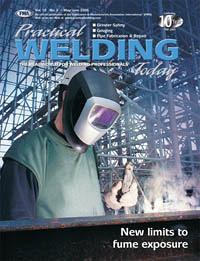Contributing Writer
- FMA
- The Fabricator
- FABTECH
- Canadian Metalworking
Categories
- Additive Manufacturing
- Aluminum Welding
- Arc Welding
- Assembly and Joining
- Automation and Robotics
- Bending and Forming
- Consumables
- Cutting and Weld Prep
- Electric Vehicles
- En Español
- Finishing
- Hydroforming
- Laser Cutting
- Laser Welding
- Machining
- Manufacturing Software
- Materials Handling
- Metals/Materials
- Oxyfuel Cutting
- Plasma Cutting
- Power Tools
- Punching and Other Holemaking
- Roll Forming
- Safety
- Sawing
- Shearing
- Shop Management
- Testing and Measuring
- Tube and Pipe Fabrication
- Tube and Pipe Production
- Waterjet Cutting
Industry Directory
Webcasts
Podcasts
FAB 40
Advertise
Subscribe
Account Login
Search
Tips for uphill MIG welding
- By Marty Rice
- Updated February 29, 2024
- November 5, 2014
- Article
- Arc Welding
Q: What patterns is used in uphill gas metal arc welding (GMAW), and what amperage should I use on 0.25-in. plate using 75 percent argon/25 percent carbon dioxide shielding gas? Where I work—I build farm equipment—there’s no need for uphill welding, so I like to practice at lunch.
A: Practice at lunch? That’s awesome!
Think of the vertical weld pool as a shelf you’re building. Keep it level as you move straight across side to side, or make a slight U downward into the weld pool. Move quickly through the center while hesitating on the sides to tie in to the base metal.
Get Into a Rhythm
Always watch both sides of the weld pool, and don’t get into the habit of counting. You’ll get a rhythm going, but you want to see it tie in before you move from the side. If you don’t tie it in properly, you’ll cut into the steel without depositing any filler metal. This is called undercut: the cardinal sin of weld defects.
Bead Size Considerations
I usually use from 0.125- to 0.25-in. stickout. A good technique to learn with is to weave a wide bead, from 0.75 to 1 in. As you master that, reduce your width until you can run small stringer beads about 0.25 in. wide. Always run your beads in the joint, not on the plain face of a piece of steel.
The first pass is the hardest one to control. You then have that bead to tie in to, making the next beads easier to run.
Fine-Tuning the Power
Every machine runs differently, but I usually use around 200 to 250 amps (wire feed) and 20 volts on mind. You can find-tune it from there. When it’s running right, it’ll sound like bacon frying. Good luck, and keep up that great work ethic!
About the Author

Marty Rice
High School Career Center in Texas
Questions for the author can be e-mailed to vickib@thefabricator.com
About the Publication
subscribe now

The Welder, formerly known as Practical Welding Today, is a showcase of the real people who make the products we use and work with every day. This magazine has served the welding community in North America well for more than 20 years.
start your free subscription- Stay connected from anywhere

Easily access valuable industry resources now with full access to the digital edition of The Fabricator.

Easily access valuable industry resources now with full access to the digital edition of The Welder.

Easily access valuable industry resources now with full access to the digital edition of The Tube and Pipe Journal.
- Podcasting
- Podcast:
- The Fabricator Podcast
- Published:
- 04/30/2024
- Running Time:
- 53:00
Seth Feldman of Iowa-based Wertzbaugher Services joins The Fabricator Podcast to offer his take as a Gen Zer...
- Industry Events
Pipe and Tube Conference
- May 21 - 22, 2024
- Omaha, NE
World-Class Roll Forming Workshop
- June 5 - 6, 2024
- Louisville, KY
Advanced Laser Application Workshop
- June 25 - 27, 2024
- Novi, MI
Precision Press Brake Certificate Course
- July 31 - August 1, 2024
- Elgin,
































